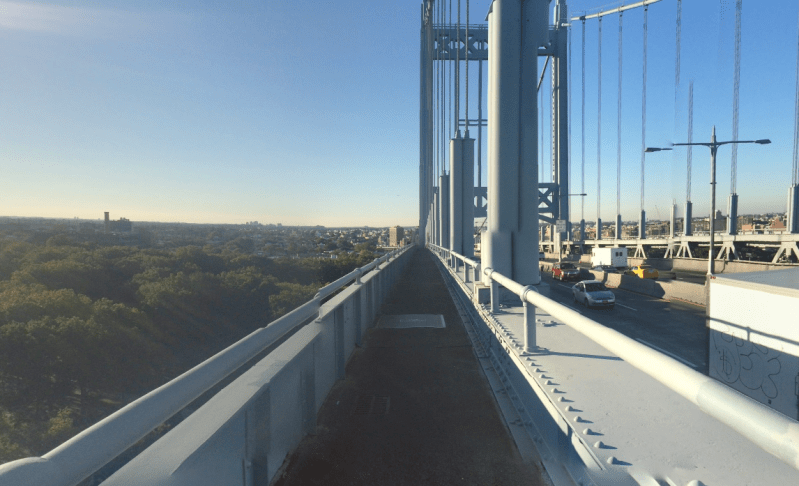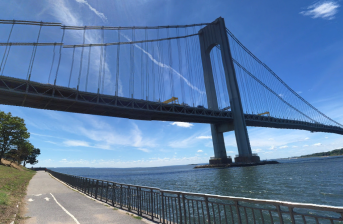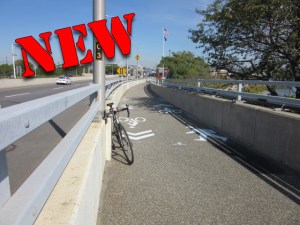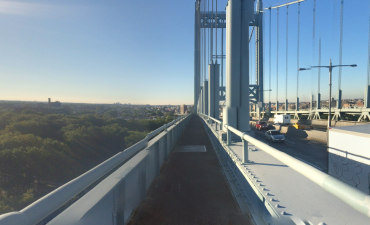MTA Wants Proof of Demand to Turn Bridge Lanes into Bike Paths

A MTA official said on Wednesday that the agency needs to see proof that cyclists would use its bridges before the agency would repurpose a vehicle lane for a bike path — which one advocate dubbed “stupid” because there’s no way to show demand when biking remains illegal on the spans.
Creating more space for cyclists typically demonstrates the pent-up demand, as was the case on the Brooklyn Bridge when the city installed a new path in the roadway last year and two-wheeled crossings immediately skyrocketed.
“It’s hard to know what [the MTA] are talking about,” said Jon Orcutt of Bike New York. “Are they asking the bike community to prove a theoretical or are they asking people to just ride over their bridge and ignore the rules?
“They shouldn’t be saying stupid things like that,” he added. “They’re clearly uncomfortable with taking a lane.”
Orcutt’s comment came after the MTA’s monthly board meeting where the agency announced it had legalized cycling on one of its seven bridges and would allow riding on the Henry Hudson Bridge after it’s renovated in 2025, as Streetsblog first reported.
After, Streetsblog asked MTA’s senior adviser for special projects Jessica Mathew whether any of the agency’s spans could get the Brooklyn Bridge treatment.
“The demand needs to be there in order for that to make sense,” said Mathew.
Despite the ban, many cyclists do use the Robert F. Kennedy and Marine Parkway Bridges, which have narrow paths. And cyclists would likely use the agency’s other spans, such as the Throgs Neck, Bronx-Whitestone, and Verrazzano Bridges, but there is currently no safe space for them.
Advocates praised the MTA’s announcement to open two of its seven spans, but they slammed the demand argument.
“It’s disingenuous because the MTA knows that it’s a catch-22 that cyclists have a hard time showing demand on bridges they don’t have access to in the first place,” said Rose Uscianowski, a Staten Island and southern Brooklyn organizer for Transportation Alternatives.
MTA officials are set to release a report required by state law on expanding bike and pedestrian access to its facilities by the end of this year, and these moves were early developments from that study.
“We’re definitely looking at all opportunities, low-cost options are definitely on the table,” Mathew said.
The transportation official previously told Streetsblog that the MTA is eyeing opening the RFK to cyclists, saying that there was a lot of “latent demand” there due to its connection to Manhattan.
The transit agency also wants to work with the city to add more bike racks near train stations and to the front of more buses crossing their bridges.
Bike trips over the Brooklyn Bridge nearly doubled within the first month after the city repurposed a roadway lane for a two-way bike path in 2021. The iconic span’s narrow wooden path shared with pedestrians had suffered years of declining trips, even as the numbers of bike crossings over the other East River bridges increased.
Uscianowski and other activists on both sides of the Verrazzano Bridge have for decades fought for the MTA to grant space to cyclists and pedestrians on that span, with rallies, petitions, and proposals to ease travel between Brooklyn and Staten Island, which is currently only possible by car or by taking the bus.
“There are a lot of families split between the boroughs,” said Uscianowski. “Right now families typically use a car to get between the two boroughs, because it’s the easiest.”
One brave man notoriously crossed the Staten Island span on his bike in the summer of 2020.
Just saw a guy riding his FUCKIN BICYCLE over the Verrazano bridge lmfaooo pic.twitter.com/65RVmM0aKs
— Don Finesse (@stevequigleyYEW) August 12, 2020
Mathew has said the big bridge is “the most challenging” of all its connectors for such a project, even though the agency in the past dismissed relatively cheap proposals and came up with a hugely expensive lane scheme, effectively killing the idea.
Plenty of cyclists already cross the narrow footpath along the Marine Parkway Bridge as well, fending for space with pedestrians and fishers casting their lines off the span, noted Orcutt.
When asked for more comment, MTA spokesman Sean Butler said the agency is studying where transportation demand is most likely to occur based on population, job densities, demographics, land use, and other factors.



